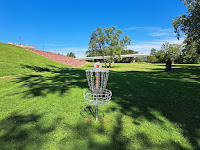Basic Information
Course Location: Nesbitt Park
Geographic Location: west side of the Susquehanna River in Wilkes-Barre, PA (41.25344, -75.88280)
Date Visited: September 2023
Number of Holes: 9
Course Length: 2609 feet, par 27
Cost to Play: free
Difficulty Level: recreational, low
Difficulty Level: recreational, low
Carts: should be fine here
Potential to Lose Discs: very low
Park Information: https://downtownwilkesbarre.org/go/nesbitt-park
DG Course Review Page: https://www.dgcoursereview.com/courses/nesbitt-park.9086
UDisc Page: https://udisc.com/courses/nesbitt-park-wyeQ
Course Walkabout Video: (coming July 12)
Driving Directions: From downtown Wilkes-Barre, cross the N Street Bridge to the west side of the Susquehanna River, then turn right onto 1st Avenue at the first intersection. 1 block later, turn right to enter Nesbitt Park. Cross the levee and park at the main parking lot at the end of the main park road. #1 tee is beside the parking lot near the entrance road.
Course Constructions:
Tees: concrete pavers, 1 per hole
Baskets: Mach V, 1 per hole
Signage: (none)
Amenities: picnic tables, bike trail
Summary Review: 1.5 Stars (out of 5)
The disc golf course at Nesbitt Park occupies a nearly flat sparsely treed plot of land inside the Susquehanna River levee between 2 Susquehanna River bridges. There are some beautiful old sycamore trees here, and the bridges add some interesting architectural scenery to this course. Unfortunately, the previous sentence might contain the two best things about this course. While some holes have decent length, most holes are completely open with no obstacles between the tee and basket. Thus, skilled and experienced disc golfers will find nothing of interest on the disc golf front here. The grass had been mowed recently when I came here. This course sits inside the Susquehanna River levee, so mud and flooding can be a problem here with enough rain. Perhaps surprisingly, this course is rather popular: there were 2 other groups playing the course when I came here on a beautiful Saturday afternoon. The fact that this is the only course in Wilkes-Barre might have something to do with its popularity. In summary, this course is worth playing once for the riverside scenery/location and maybe more often for a quick and casual half-round, but it offers no holes you will remember for the disc throwing and thus almost surely won't make your list of favorite courses.
Hole-by-Hole Review
Distances taken from dgcoursereview.com; link provided above. Picture sequence for each hole is 1) tee, 2) approach, 3) basket to tee.
Hole #1: 187 feet, par 3
Comments: a couple of large trees guard the right side, but there is plenty of room to the left. A left-to-right disc flight with controlled height should set up a birdie opportunity. #2 tee is behind the basket and to the right.
Hole #2: 311 feet, par 3
Comments: while there are a few trees to the left or right, there are none directly between the tee and basket. Thus, a straight throw below the tree canopy will get the job done. #3 tee is behind the basket and to the right.
Hole #3: 249 feet, par 3
Comments: very similar to hole #2 but with a tree on either side of the basket. #4 tee is behind the basket and to the right.
Hole #4: 236 feet, par 3
Comments: a cluster of large trees stands between the tee and basket, but there is plenty of room to go around either side. This is the only hole that forces you to pick a line and execute a throw. #5 tee is to the right.
Hole #5: 324 feet, par 3
Comments: a completely open and completely boring hole. The Susquehanna River bridge behind the basket is the less attractive of the two river bridges on this course. Watch for pedestrians and cars on the park entrance road to the right. #6 tee is to the left and back toward the tee, at the base of the levee.
Hole #6: 357 feet, par 3
Comments: now the course turns to play the opposite direction for the last 4 holes, which could matter on a windy day. The levee is close to the right, and it could affect your throw or stance if you miss while trying to stay right of a medium-sized tree. #7 tee is behind the basket.
Hole #7: 239 feet, par 3
Comments: some large trees guard the right side, but there is quite a bit of room to the left. The tree limbs overhead also present an obstacle. #8 tee is behind the basket.
Hole #8: 393 feet, par 3
Comments: you need to avoid one large tree in front and to the right of the tee, but beyond that this hole is completely open. #9 tee is behind the basket on the other side of the parking lot.


















































































